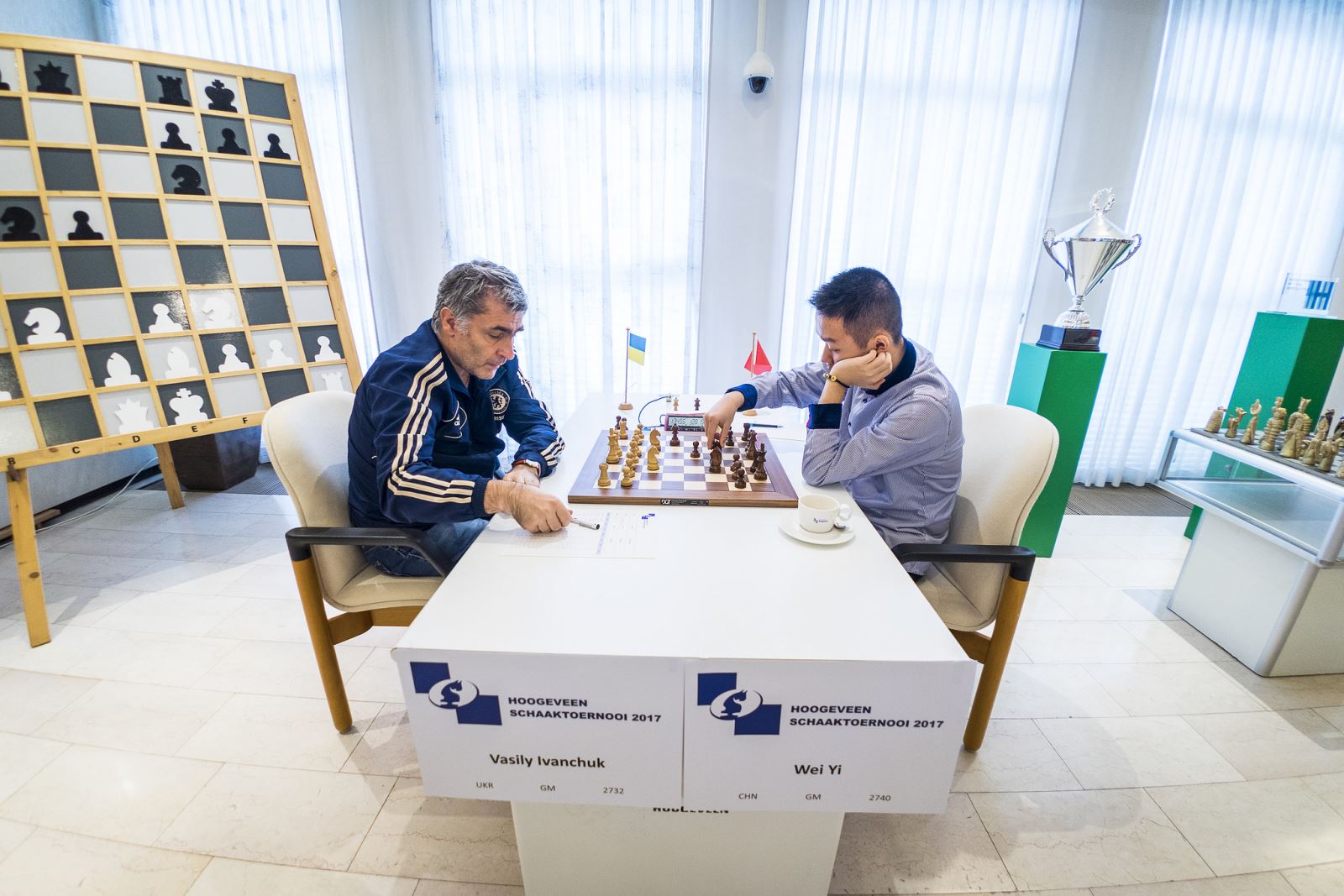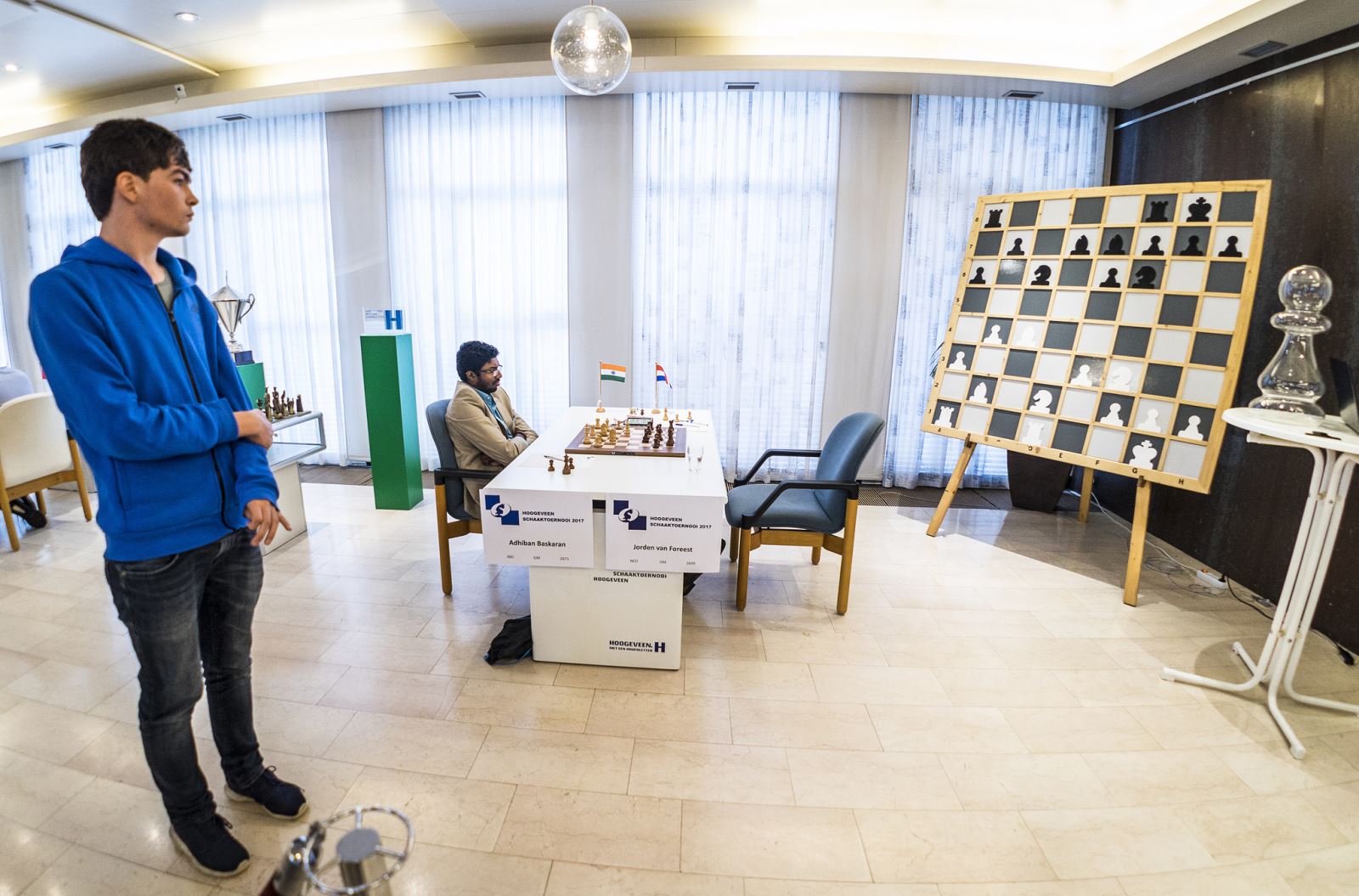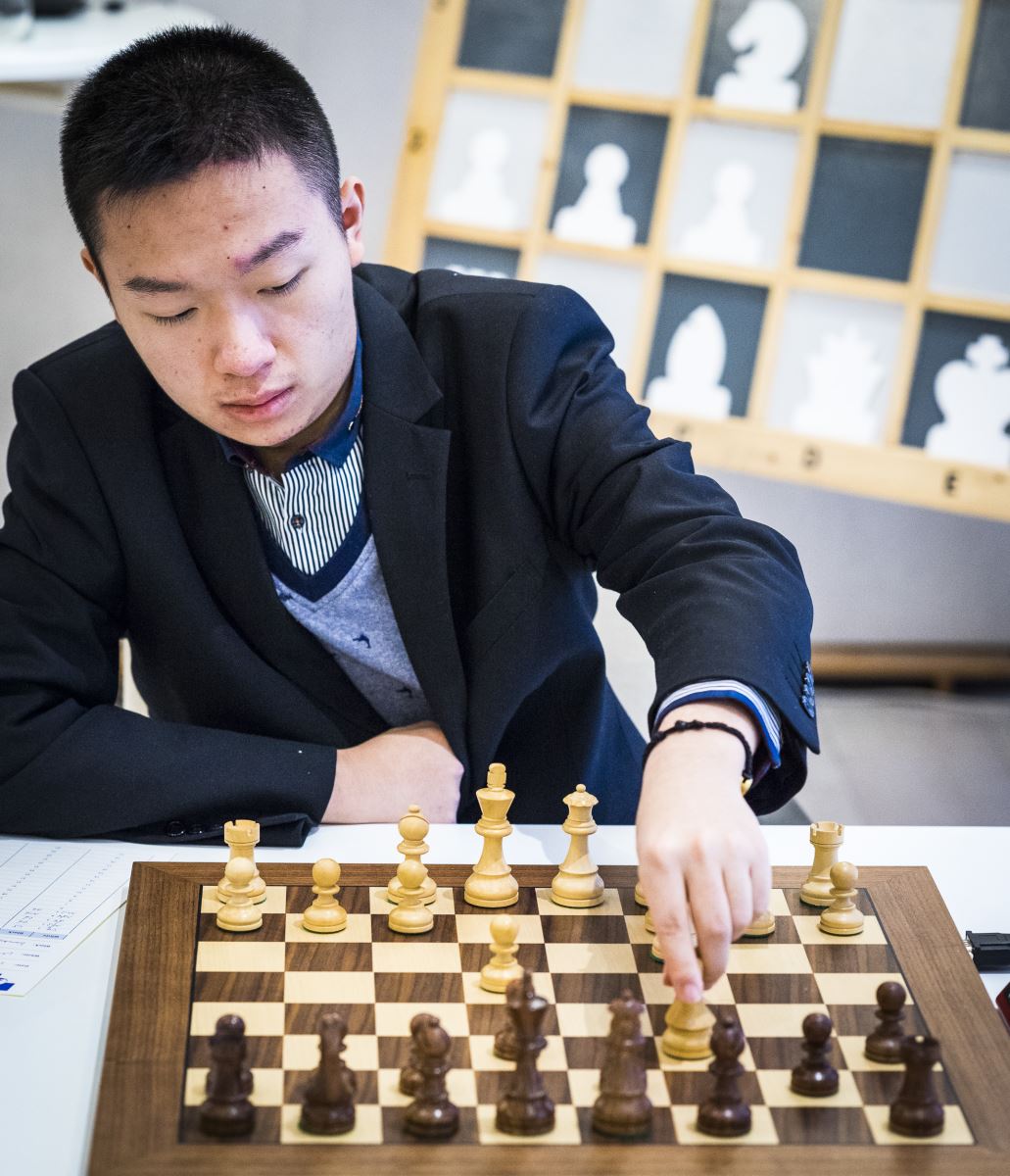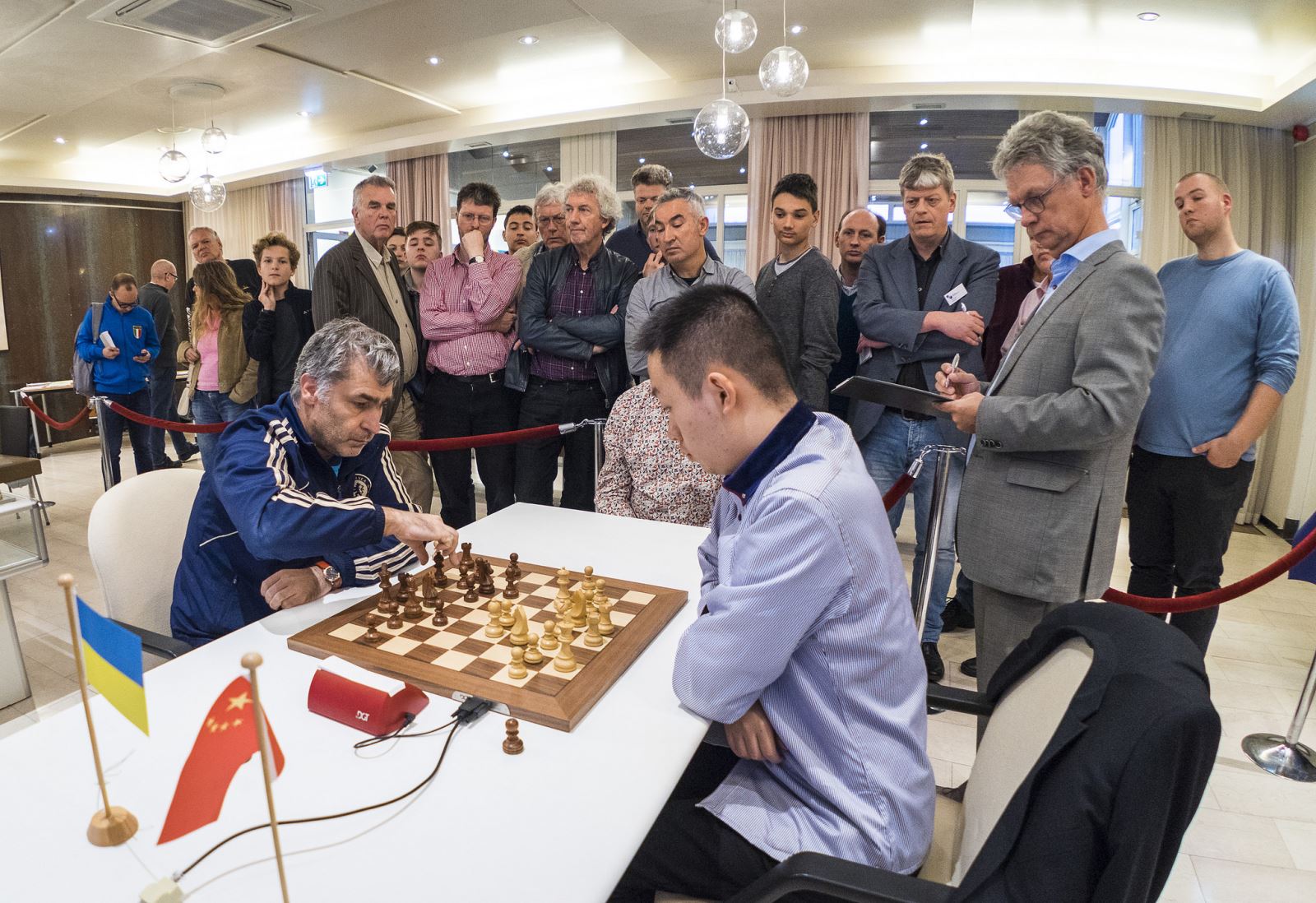


ChessBase 17 - Mega package - Edition 2024
It is the program of choice for anyone who loves the game and wants to know more about it. Start your personal success story with ChessBase and enjoy the game even more.
Picking up where we left off at the half way mark, Vassily Ivanchuk was out in front by a point over the Chinese Champion, and van Foreest had just pulled level with his Indian opponent.
On Tuesday evening, Adhiban Baskaran was perhaps lost musing on where exactly he mixed up his prep in his fourth game against Jorden van Foreest. Keeping up the trend so far, of alternating between the Queen’s Gambit accepted and the Italian, the players essayed the modest king’s pawn opening once again.

Jorden van Foreest was evidently happy to have levelled scores with Adhiban | Photo: Lennart Ootes
Adhiban, with whom van Foreest had now levelled scores, seemed to be desperate to regain his lead. Out of the opening, he audaciously rolled his pawns down the king-side. His 13th move, 13…h5, was in fact, never seen in grandmaster play before. And even though there was no concrete attack in sight, Adhiban, with his kingside expansion, hoped to wreak havoc in white’s camp. Was this a plausible novelty or a gross overextension?
An important consideration was that the situation in the centre wasn’t clear. And as theory dictates, overextension on the wings is usually punished through the centre. Sticking to this principle, van Foreest broke the centre open with 16.dxe5.
You can play the variations right on the live diagram!
At this point, Adhiban’s knight was en prise and if he took back with 16…dxe5, a queen exchange would not only fizz out his attack but also cost him some pawns: 16...dxe5 17.Qxd8+ Kxd8 18.Bxa7 Rxa7 19.fxg4 Nxe4 20.Rae1 and white is clearly better.
Things looked bleak. Leaving the centre to its fate, Adhiban sought counterplay on the kingside by piling up his pieces there.

Needless to say, he was taking a gamble. But perhaps, his best chance.
Van Foreest could simply have gobbled another pawn with 20.exd6. But instead of letting his opponent unnecessarily complicate the position with 20…Qg5 in return, he, very pragmatically, chose 20.f4 — a move which stalled black’s preposterous attack once and for all.
Soon Adhiban was forced into an endgame where he was not only a pawn down but also had the several weak pawns scattered around the board. A second pawn fell soon after. It didn’t take long for van Foreest to convert this ending into a win.
No matter what his match situation is, Adhiban is always in high spirits | Photo: Lennart Ootes
Attack with the Modern Italian
In recent years the Italian Game has undergone a renaissance, transforming it from the Cinderella of 1.e4 openings into a major system which offers excellent chances for White to gain the advantage.

Ivanchuk contemplates his lead | Photo: Lennart Ootes
In the other match, Ivanchuk went for the Sicilian yet again, but this time, it was the Taimanov. Just like Adhiban, Ivanchuk was also a couple of pawns down. But unlike in Adhiban’s case, the weak pawns in his game were in his opponent’s camp.
Some of Ivanchuk's moves looked strange at the outset, but it turned out that he knew exactly what he was doing. Out of the opening, he gave up not one but two pawns to shatter Wei's pawn structure and gain enough counterplay.
17.Bg5 h4 18.Bxc6+ Bxc6 19.Ne4 Bxe4 20.Rxe4 h3
This audacious advance prevented Wei from claiming any advantage, and the Chinese teenager said he should perhaps have captured the pawn immediately after it reached h3 instead of bringing the rook out which led to its exchange. But in any case, black would have enjoyed sufficient counterplay. The players drew by repetition by move 33.
Sicilian Paulsen Powerbook 2016
In our Powerbook we have brought together all games with the ECO codes B40-B49. Added to 62 000 selected master games from both Mega and correspondence chess there 122 000 high class games from the engine room on playchess.com.
Going into the penultimate round, leaders had emerged on both boards. While Ivanchuk had kept his lead with a draw against Wei, Jorden van Foreest, with two consecutive wins had overtaken Adhiban. With just two more rounds to go, the road ahead was difficult for the ones trailing behind.
Desperate for a win, Wei Yi fought with all his might in round five. Ivanchuk, with the white pieces, played a novelty on move 13 in the Rubinstein variation of the Nimzo-Indian but soon ended up conceding a small edge to his Chinese opponent. Creative as he is, Wei then sacked his queen for a rook and a minor piece and began pushing on the queenside.
My best games in the Nimzo-Indian
With this DVD on the Nimzo-Indian Defence (including the Catalan and the Queen‘s Indian) Alexei Shirov continues the successful and highly praised series about his best games. As in the preceding DVDs the Latvian super grandmaster succeeds in spoiling his public with analysis of a high quality and with exciting insights into his games, and he does so in his own reserved, pleasant and modest style. Among the opponents are, for example, Topalov and Leko.
Here instead of the entering the line 19...Nxe4 20.Bxe4 Qe5, 21.Bxh7 Kh8 22.Bd3 Bd6! 23.f4 Qxe3+, Wei opted to muddy the waters with 19...dxe4 20.Rxd6 Bxd6 21.Qd1 Be5 22.Be2 Bxb2

Wei Yi shot out an interesting queen sacrifice at Ivanchuk | Photo: Lennart Ootes
By move 28, he gave up a further exchange, to keep his far advanced queenside passer alive, and was left with only two minor pieces against Ivanchuk’s queen. However, one of the perks of having more material is that you can give it back if the situation demands. Soon, Ivanchuk gave back the extra exchange to get rid of his opponent’s dangerous passer and reached an endgame where both sides had equal pawns on the queenside. The big difference, though, was that Ivanchuk had a queen against Wei’s rook and knight. If Ivanchuk had succeeded in extracting a win from this position, he would have won the match with a round to spare. Understandably, Ivanchuk tried hard for almost fifty moves to bring home victory. But Wei's fortress left him no choice but to sign the truce.
However, this draw meant that Wei Yi was in a must-win situation in the final round. And with the white pieces in hand, he was sure to come out all guns blazing.

It seems, van Foreest preferred analysing his position on the demonstration board | Photo: Lennart Ootes
Adhiban, after his win in round two, had lost two consecutive games against the Dutch GM Jorden van Foreest. And to add to it, playing against the same opponent, to whom he had lost those two games, must have made it all the more difficult.
But Adhiban is made of sterner stuff; his optimism knows no bounds. Despite his blunder in the third game, regardless of his prep mix-up in round four, Adhiban went into the fifth round undeterred. Keeping in mind that the games so far had been alternating between the Queen's Gambit Accepted and the Italian, the Indian number five came to the board with thorough preparation, got a slight edge out of the opening and fostered it immaculately to take home the full point.
Until quite late in the game, the position had remained thoroughly equal. Queens were traded quite early, the exchange of rooks and a pair of minor pieces followed soon. It all looked well balanced when van Foreest gave Adhiban a small window of opportunity on move 30.
After 29...Bd6 30.Rxh5, Adhiban was a pawn ahead. But the position was far from won; van Foreest had decent activity with pieces. Besides, this wasn’t the first time in this match that he was a pawn down against Adhiban.
More pawn trades left both sides with pawns on opposite wings. By now, Adhiban had acquired a clear edge. But it was a race now. It did not matter who had more pawns, who queened first would decide the game. Of course, the silicon machines gave Adhiban a decisive advantage by now. But with pawns rolling down on opposite wings and no forced win in sight, one must always be on his toes not to fall for tricks.
And Adhiban did just that. Sacrificing a pawn — although only temporarily — he got his pawns rolling decisively while keeping van Foreest’s pawns in check and forced resignation. Do take a look at the game with detailed analysis below.
The Queen's Gambit Accepted: A Repertoire for Black
In this DVD Sam Collins presents a repertoire for Black based on the Queen’s Gambit Accepted, 1.d4 d5 2.c4 dxc4. Rather than get involved in the heavy theory of the Classical Main Line, the lynchpin of the repertoire is the active development of the queen’s bishop. The resulting positions have close similarities to the Nimzo Indian and Slav Defences, and Collins explains the way for Black to approach the middlegame with confidence based on a blockade and light square strategy. The resulting repertoire is solid, reliable, and suitable as either a main weapon or an occasional surprise choice. Video running time: 3 hours 30 min
 Going into the final round, We Yi needed a win as badly as anyone can imagine. This was not only because he would lose the match if he didn't win, but also since he had not won a game against Ivanchuk in five tries.
Going into the final round, We Yi needed a win as badly as anyone can imagine. This was not only because he would lose the match if he didn't win, but also since he had not won a game against Ivanchuk in five tries.
Once again, the Taimanov variation appeared on the board. But this time, Wei went for a sharper version with 9.Qe2 and 11.f4 and even tossed in a novelty with 13.Bg3 to counter it. Ivanchuk only needed a draw and thought it was best to avoid pawn grabbing with 13...Qb6+ opting instead to castle.
Wei got in the typical Sicilian pawn breaks with e5 and f5 to induce weaknesses around Ivanchuk's king and began engineering an attack with some neat manoeuvre with his queen and bishop. Ivanchuk cracked under this pressure exerted by the white pieces and soon the white pieces came crashing in.

Of course, Ivanchuk wasn't very happy with this turn of events | Photo: Lennart Ootes
After the game, Wei pointed out that Vassily should have tried 22…Nf6 instead of 22…h5 which allowed white's pieces enter the black camp.
Adhiban and van Foreest, meanwhile, had exchanged quite a few blows before going into the final game of their match in Hoogeveen. Every game, except the first one, had ended decisively. But in the final round, it ended just as it had started as the players agreed to a draw, letting a blitz tie-break decide the fate of the match.

For the third time in a row, in game six, Adhiban countered Jorden van Foreest’s 1.e4 with the Italian | Photo: Lennart Ootes
Unlike in their previous Italian battle, instead of the 6.d6 line, he went with 5.O-O and 6.d5 which is a more direct way of approaching the position.
Van Foreest, too, had a small surprise up his sleeve. On the 10th move, instead of playing it cool with 10.Nbd2, he went for the more audacious b4-b5 pawn push in the centre and eventually gobbled a pawn on e5. But Adhiban reacted well and countered the Dutchman’s attempts to generate play on the kingside and centre by exchanging his knight for van Foreest’s light-squared bishop and then harvesting the weak pawns that were left behind. By move 33, Adhiban had recovered his pawn while van Foreest found a rook exchange that led to a forced repetition of moves.
With scores tied at 3-3, the players went into a two-game blitz playoff with a time control of 3 minutes plus 2 seconds increment from the first move.
Adhiban had the black pieces in the first game and was pushed to the back foot after an overextension on the queenside in a London System. Once he had the initiative, van Foreest’s knights began to tango all over the board. Soon, his pawns also plunged in both on the kingside and in the centre. In order to curb white’s initiative, Adhiban decided to sac a piece. But this did not really help his case and had to resign soon after.
"Simple yet aggressive!" Enjoy this new exciting DVD by Simon Williams. Let the famouns Grandmaster from England show you how to gain a very exciting yet well founded opening game with the London System (1.d4 d5 2.Bf4).

Despite losing the first blitz game, Adhiban was seen smiling! | Photo: Lennart Ootes
Now a point ahead, it seemed van Foreest was in the mood for some pawn fishing. Or perhaps, his nerves were failing him badly. First, his queen came wandering to a2, having gobbled a pawn on b3. And then, his knight also couldn’t resist the temptation of munching on the c3 pawn on the 24th move. Incredibly, the knight was en prise there and even Adhiban ignored capturing it! What’s even more curious is that Adhiban could have won on the spot a couple of moves later but went for an exchange sacrifice that spoiled his advantage. Van Foreest regrouped well after this and forced resignation in a few moves.

Even though Wei Yi and Vassily Ivanchuk were pretty evenly matched in classical games, the blitz playoff painted a totally different picture | Photo: Lennart Ootes
In the first game, Wei was able to win a pawn from the black side of a Nimzo-Indian. But soon things began going south for him as Ivanchuk’s pieces came rushing in through the centre. This made Wei consume a lot of time on his clock and eventually left him a pawn down in a lost position. Ivanchuk took his time converting this one but there was never really a doubt about the game’s outcome.
In the final game, Wei Yi went down without a fight after Ivanchuk played the central break 14…e5 in the Scandinavian. Maybe it was the match situation or perhaps Wei was just tired as he blundered and lost a piece. In just 18 moves, ‘Chucky’ won the game and, with it, the match.
